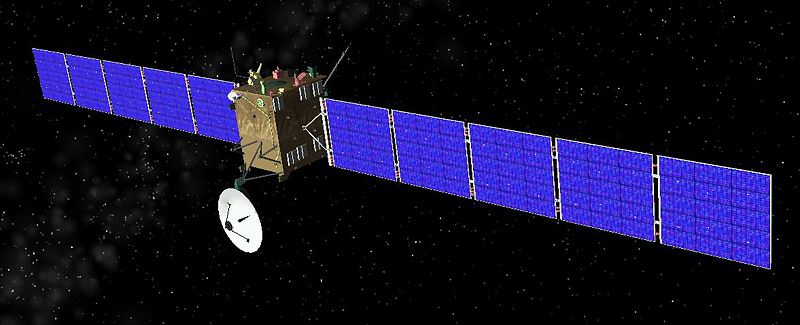Host: Fraser Cain (@fcain)
Guests:
Morgan Rehnberg (cosmicchatter.org / @cosmic_chatter)
Brian Koberlien (@briankoberlein)
Alessondra Springmann (@sondy)
Matthew Francis (CosmoAcademy.org, @DrMRFrancis)
Continue reading “Weekly Space Hangout – June 6, 2014: Comets & Cosmos?”
New Arecibo Radar Images Show Comet Responsible for Camelopardalids is an Icy, Cratered Mini World
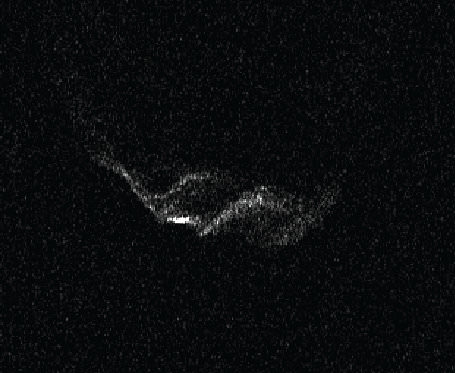
When Comet 209P/LINEAR — the comet that brought us the Camelopardalids meteor shower last weekend – was first discovered in February of 2004, astronomers initially thought it was an asteroid. However, subsequent images of the objects showed it had a tail, and so it was reclassified as a comet. Now, new images taken by the Arecibo Observatory planetary radar system reveal Comet 209P/LINEAR has complex surface features that will require more analysis to fully interpret. This mini world seems to be filled with ridges and cliffs along with its icy surface.
“This is the highest resolution radar image we have obtained of a comet nucleus,” said Dr. Ellen Howell from the Universities Space Research Association, who led the observations of the comet at Arecibo, located in Puerto Rico.
The Arecibo Observatory is taking advantage of the approaching close pass of Earth by Comet 209P/LINEAR, taking these new radar images which confirm this comet to be about 2.4 by 3 km kilometers (1.5 x 1.8 miles) in size and elongated in shape. Earlier optical observations suggested this size range, but now these radar observations are the first direct measurement of the nucleus dimensions.
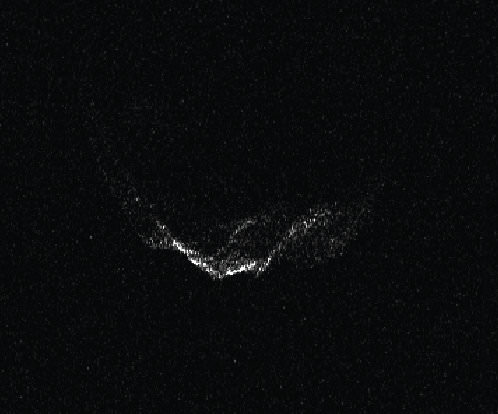
Comets very rarely come this close to Earth, but don’t worry: Comet 209P/LINEAR is not coming close enough to cause any problems or concerns.
“Comet 209P/LINEAR has no chance of hitting Earth,” said data analyst Alessondra Springmann from Arecibo. “It comes no closer than 8.3 million kilometers (5.2 million miles) to Earth, safely passing our planet.”
But this relatively close pass makes this an extraordinary opportunity to get images of the surface. As Dr. Howell noted, these observations of are some of the most detailed. Just six comet nuclei have been imaged by spacecraft, and a wide variety of surface features and structures have been observed on these icy objects.
“We are being cautious,” Howell told Universe Today. “Radar images are not regular “spatial” images, and one can easily be misled by treating them as a regular picture. But proper analysis will take weeks or months, not minutes. What these radar images show is certainly not ordinary, but we don’t really have anything to compare to. The image looks different than asteroids we have imaged, but I don’t know what is due to surface feature differences and what might be scattering differences by the surface material.”
Comets have a central nucleus made of ice, dust, and rocks, and a coma of dust and gas. Two tails, one made of ions and one of dust, form in the direction pointing away from the sun.
Other comets seen by Arecibo radar include 103P/Hartley 2 and 8P/Tuttle, and 73P/Schwassmann-Wachmann 3.
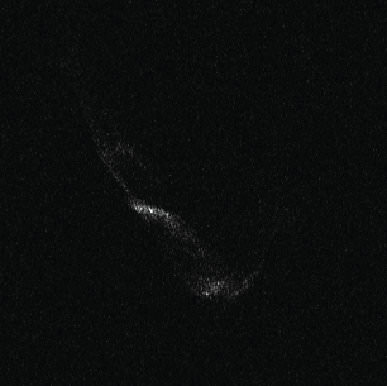
Unlike long period comets Hale-Bopp and the late Comet ISON that swing around the Sun once every few thousand years or few million years, Comet 209P/LINEAR visits our neighborhood frequently, coming ‘round every 5.09 years. However, it will not be close enough to Earth again for radar imaging any time in the next 100 years.
With a rotation period of approximately 11 hours as determined by Carl Hergenrother at the University of Arizona using the 1.8 meter VATT telescope, this comet is one of the many Jupiter family comets, which orbit the Sun twice for every time Jupiter orbits once.
It was discovered by the Lincoln Laboratory Near-Earth Asteroid Research (LINEAR) automated sky survey.
The Arecibo Observatory, located in Puerto Rico, is home to the world’s largest and most sensitive single-dish radio telescope at 305 meters (1000feet) across. This facility dedicates hundreds of hours a year of its telescope time to improving our knowledge of near-Earth asteroids and comets.
Dr. Howell specializes in studying comets and asteroids using radar, as well as passive radio and infrared spectroscopy techniques to determine the surface and coma properties of small solar system bodies. She was assisted in these observations of Comet 209P/LINEAR by Michael Nolan, Patrick Taylor, Alessondra Springmann, Linda Ford, and Luisa Zambrano.
Arecibo Observatory, and the complementary Goldstone Solar System Radar in California run by NASA’s Jet Propulsion Laboratory, are both observing comet 209P/LINEAR during its pass by Earth in May. These radar facilities are unique among telescopes on Earth for their ability to resolve features on comets and asteroids, while most optical telescopes on the ground would see these cosmic neighbors simply as unresolved points of light.
For more images and information on Comet 209P/LINEAR, see the Arecibo Observatory’s planetary radar page.
The Arecibo Observatory is operated by SRI International under a cooperative agreement with the National Science Foundation, and in alliance with the Sistema Universitario Ana G. Méndez-Universidad Metropolitana and the Universities Space Research Association. The Arecibo Planetary Radar program is supported by NASA’s Near Earth Object Observation program.
Astronomy Cast Ep. 343: The Universe is Trying To Kill You!
We always say that the Universe is trying to kill you. But seriously… it wants you dead. The Bad Astronomer Phil Plait joins us for a very special episode of Astronomy Cast where we talk about all the different ways the Universe can take you out. You can listen to it here at Astronomy Cast!
Continue reading “Astronomy Cast Ep. 343: The Universe is Trying To Kill You!”
Mars-Bound Comet Siding Spring Sprouts Multiple Jets
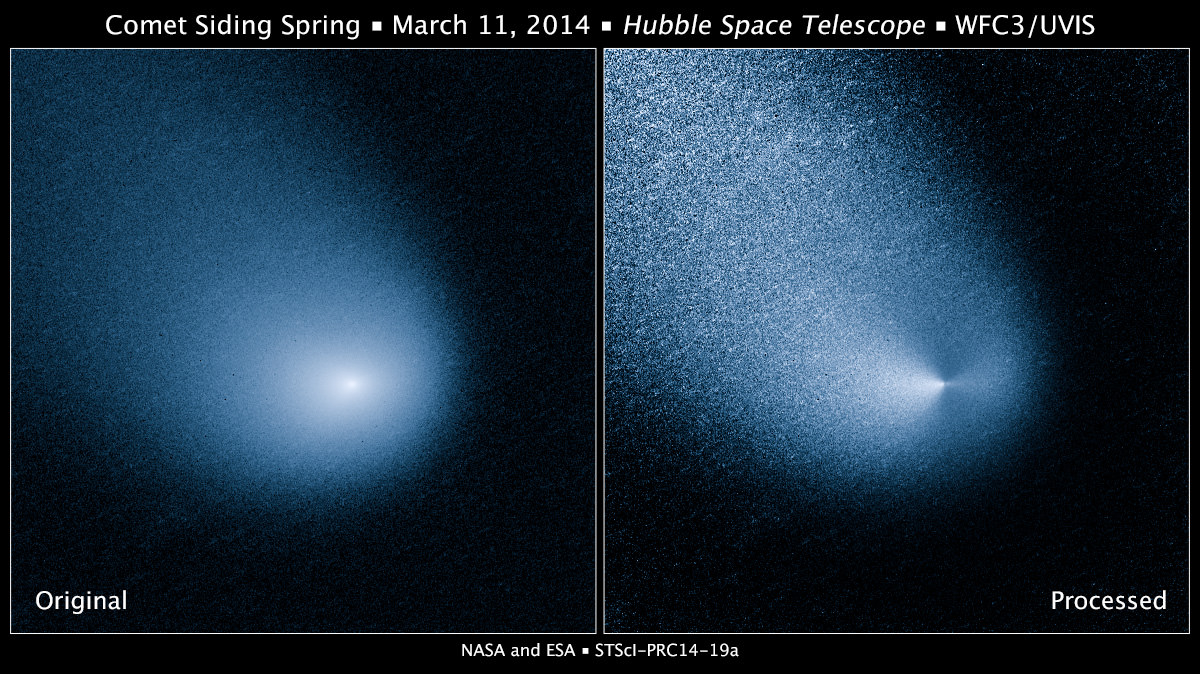
Comet Siding Spring, on its way to a close brush with Mars on October 19, has been kicking up a storm lately. New images from Hubble Space Telescope taken on March 11, when the comet was just this side of Jupiter, reveal multiple jets of gas and dust.
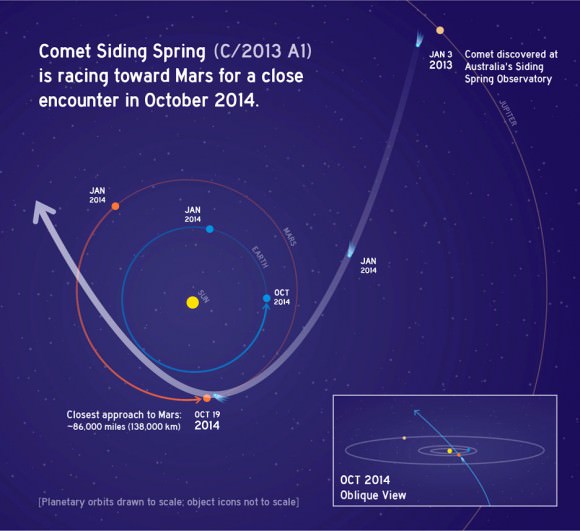
Discovered in January 2013 by Robert H. McNaught at Siding Spring Observatory in Australia, the comet is falling toward the sun along a roughly 1 million year orbit. It will gradually brighten through spring and summer until reaching binocular brightness this fall when it passes 130 million miles (209 million km) from Earth.
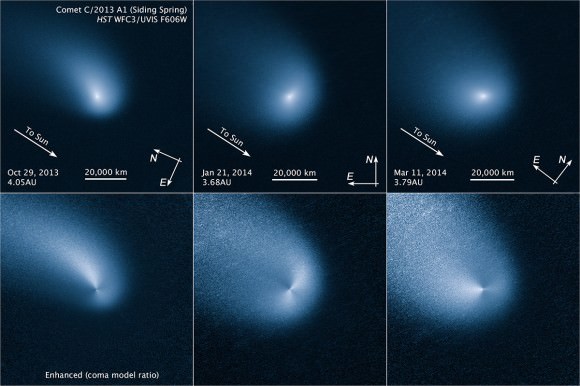
Astronomers were particularly interested in getting images when Earth crossed the comet’s orbital plane, the path the comet takes as it orbits the sun. The positioning of the two bodies allowed Hubble to make crucial observations of how fast dust particles streamed off the nucleus.
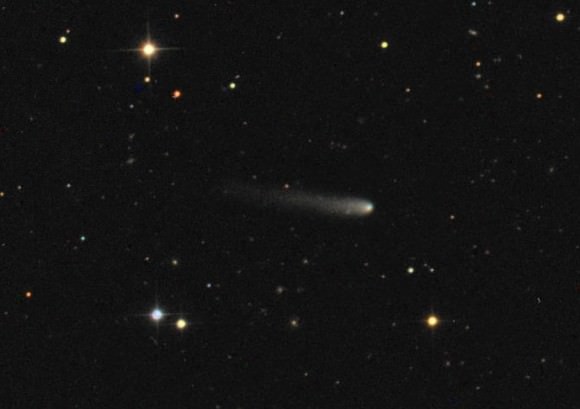
“This is critical information that we need to determine whether, and to what degree, dust grains in the coma of the comet will impact Mars and spacecraft in the vicinity of Mars,” said Jian-Yang Li of the Planetary Science Institute in Tucson, Arizona.
On October 19 this year, Comet Siding Spring will pass within 84,000 miles (135,000 km) of Mars or less than half the distance of our moon. There’s a distinct possibility that orbiting Mars probes like NASA’s Mars Reconnaissance Orbiter and the European Mars Express might be enveloped by the comet’s coma (hazy atmosphere) and pelted by dust.
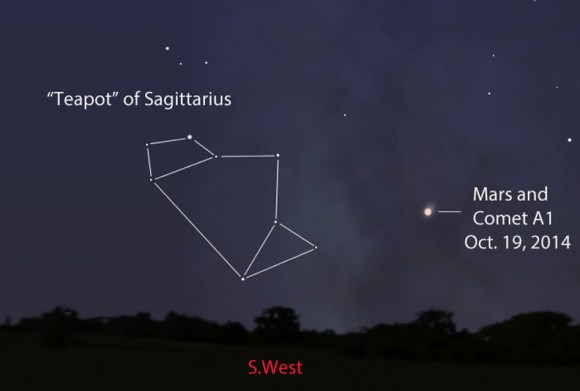
While comet dust particles are only 1 to 1/10,000 of a centimeter wide, they’ll be moving at 124,000 mph (200,000 km/hr). At that speed even dust motes small can be destructive. Plans are being considered to alter the orbits of the spacecraft to evade the worst of the potential blast. On the bright side, the Red Planet may witness a spectacular meteor storm! Protected by the atmosphere, the Martian rovers aren’t expected to be affected.
I know where I’ll be on October 19 – in the front yard peering at Mars through my telescope. Even if the comet doesn’t affect the planet, seeing the two overlap in conjunction will be a sight not to miss.
Rosetta Wakes Up, Phones Home, Starts Tweeting

The silence from the live video feed from the ESA’s space operations center in Darmstadt, Germany was almost deafening. Scientists and engineers were waiting to receive a signal from the Rosetta spacecraft, which was supposed to come out of hibernation today to begin its mission to Comet 67P/Churyumov-Gerasimenko in earnest. Finally, after waiting nearly 45 minutes into the window of time when the spacecraft was supposed to send a signal, a little blip appeared on the screens of the spectrum analyzers and the room erupted in cheers.
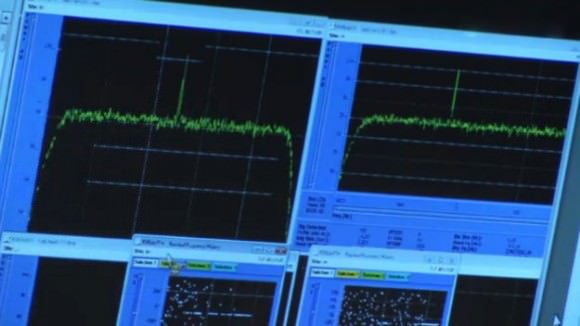
“After waiting over two and a half years, what is three-quarters of an hour!” said Fred Jansen, ESA’s Rosetta mission manager. “The spacecraft is there, it’s awake and the science team knows there are two busy years ahead of them. Now we have to work hard. Thanks to the team that achieved this.”
“I think I can speak on behalf of everyone here and everyone on Twitter: that was rather stressful!” said Matt Taylor, Rosetta project scientist. “The work begins now and I think we’ll have a fun-filled two years ahead, so let’s get on it!”
Soon after the signal arrived, the mission Twitter feed came alive, Tweeting “Hello World” in multiple languages.
Labas, pasauli!
— ESA Rosetta Mission (@ESA_Rosetta) January 20, 2014
My antennas started tingling a few hours ago with all the shouting and wonderful #wakeuprosetta messages. Thank you!
— ESA Rosetta Mission (@ESA_Rosetta) January 20, 2014
Later in the day, as the team checked out the spacecraft, everything appeared in order and working well as systems began to start operating:
#Rosettta Operations Manager Andrea Accomazzo has taken a look at the data… we look good!
— ESA Operations (@esaoperations) January 20, 2014
Rosetta was placed into hibernation in June 2011, with only the computer and several heaters remaining active as the spacecraft cruised out to nearly 800 million km from the warmth of the Sun, beyond the orbit of Jupiter.
Today, as Rosetta’s orbit came back to within 673 million km from the Sun, there was enough solar energy to power the spacecraft fully again and Rosetta’s pre-programmed internal ‘alarm clock’ woke up the spacecraft after a record 957 days of hibernation. After warming up its key navigation instruments, coming out of a stabilizing spin, and aiming its main radio antenna at Earth, Rosetta sent a signal to let mission operators know it had survived the most distant part of its journey.
The signal was received by NASA’s Goldstone ground station in California at 18:18 GMT during the first window of opportunity the spacecraft had to communicate with Earth.
The one-way light time on today, January 20, 2014 between Rosetta and Earth was about 44 minutes and 53 seconds over a distance of 807,224,610.74 km. Rosetta was about 9,188,540 km from the comet, closing up at about 800 m/second.
“This was one alarm clock not to hit snooze on, and after a tense day we are absolutely delighted to have our spacecraft awake and back online,” said Jansen.
Comets are considered the primitive building blocks of the Solar System and perhaps may have helped to ‘seed’ Earth with water, or even the ingredients for life. But many fundamental questions about these enigmatic objects remain, and through its comprehensive, in situ study of Comet 67P/Churyumov-Gerasimenko, Rosetta aims to unlock the secrets contained within.
“All other comet missions have been flybys, capturing fleeting moments in the life of these icy treasure chests,” said Taylor. “With Rosetta, we will track the evolution of a comet on a daily basis and for over a year, giving us a unique insight into a comet’s behavior and ultimately helping us to decipher their role in the formation of the Solar System.”
So schön! #WakeUpRosetta Flug frei für @Philae2014. Der Lander soll im November auf dem Kometen aufsetzen (AS) pic.twitter.com/ZlN9ZhIQJP
— DLR_de (@DLR_de) January 20, 2014
But first, essential health checks on the spacecraft must be completed. Then the eleven instruments on the orbiter and ten on the lander will be turned on and prepared for studying Comet 67P/Churyumov-Gerasimenko.
“We have a busy few months ahead preparing the spacecraft and its instruments for the operational challenges demanded by a lengthy, close-up study of a comet that, until we get there, we know very little about,” says Andrea Accomazzo, Rosetta operations manager.
Rosetta’s first images of 67P/Churyumov-Gerasimenko are expected in May, when the spacecraft is still 2 million km from its target. Towards the end of May, the spacecraft will execute a major maneuver to line up for its critical rendezvous with the comet in August.
After rendezvous, Rosetta will start with two months of extensive mapping of the comet’s surface, and will also make important measurements of the comet’s gravity, mass and shape, and assess its gaseous, dust-laden atmosphere, or coma. The orbiter will also probe the plasma environment and analyse how it interacts with the Sun’s outer atmosphere, the solar wind.
Using these data, scientists will choose a landing site for the mission’s 100 kg Philae probe. The landing is currently scheduled for November 11, 2014 and will be the first time that a landing on a comet has ever been attempted.
With almost negligible gravity from the comet’s 4 km-wide nucleus, Philae will have to use ice screws and harpoons to stop it from rebounding back into space after touchdown.
Among its wide range of scientific measurements, Philae will send back a panorama of its surroundings, as well as very high-resolution pictures of the surface. It will also perform an on-the-spot analysis of the composition of the ices and organic material, including drilling down to 23 cm below the surface and feeding samples to Philae’s on-board laboratory for analysis.
The focus of the mission will then move to the ‘escort’ phase, during which Rosetta will stay alongside the comet as it moves closer to the Sun, monitoring the ever-changing conditions on the surface as the comet warms up and its ices sublimate.
Rosetta will follow the comet throughout the remainder of 2015, as it heads away from the Sun and activity begins to subside.
You can read the team’s blog about the “wake up” here, and find out more about the Rosetta mission here.
Here’s a replay of the acquisition of signal:
Watch Live: ESA Waits for Signal from Comet-Chasing Spacecraft
UPDATE: Rosetta woke up! Read our full story about the acquisition of signal here.
For the first time, a spacecraft will follow a comet as it approaches the Sun and land on its nucleus. But today is key to the success of the mission. After nearly two and a half years in hibernation, its time for Rosetta to wake up!
Rosetta has been soaring through the inner solar system for nearly a decade –flying past Mars and Earth several times and even briefly visiting a couple of asteroids. A special ‘hibernation mode’ for the spacecraft was designed by engineers to allow it to survive the large distances from the Sun during its cruise. Since it went into hibernation on June 9, 2011, Rosetta has orbited entirely on its own completely out of contact. But now the Rosetta spacecraft is finally entering the home stretch of its mission to orbit the 4-km-wide comet 67P/Churyumov-Gerasimenko.
Watch live, above, as mission controllers at ESA await for a signal from the spacecraft. The Rosetta mission control team at ESOC is expecting to receive the signal between 17:30-18:30 UTC.
Continue reading “Watch Live: ESA Waits for Signal from Comet-Chasing Spacecraft”
Weekly Space Hangout – December 27, 2013: Year in Review & Looking Forward
Host: Fraser Cain
Guests: +Brian Koberlein (@briankoberlein), David Dickinson (@Astroguyz), Pamela Gay (@starstryder)
Big thanks to Nicole Gugliucci (@noisyastronomer) for doing a wonderful job producing this past year!
Continue reading “Weekly Space Hangout – December 27, 2013: Year in Review & Looking Forward”
Is Anything Left of ISON? Spacecraft Continue to Monitor Comet’s Remains
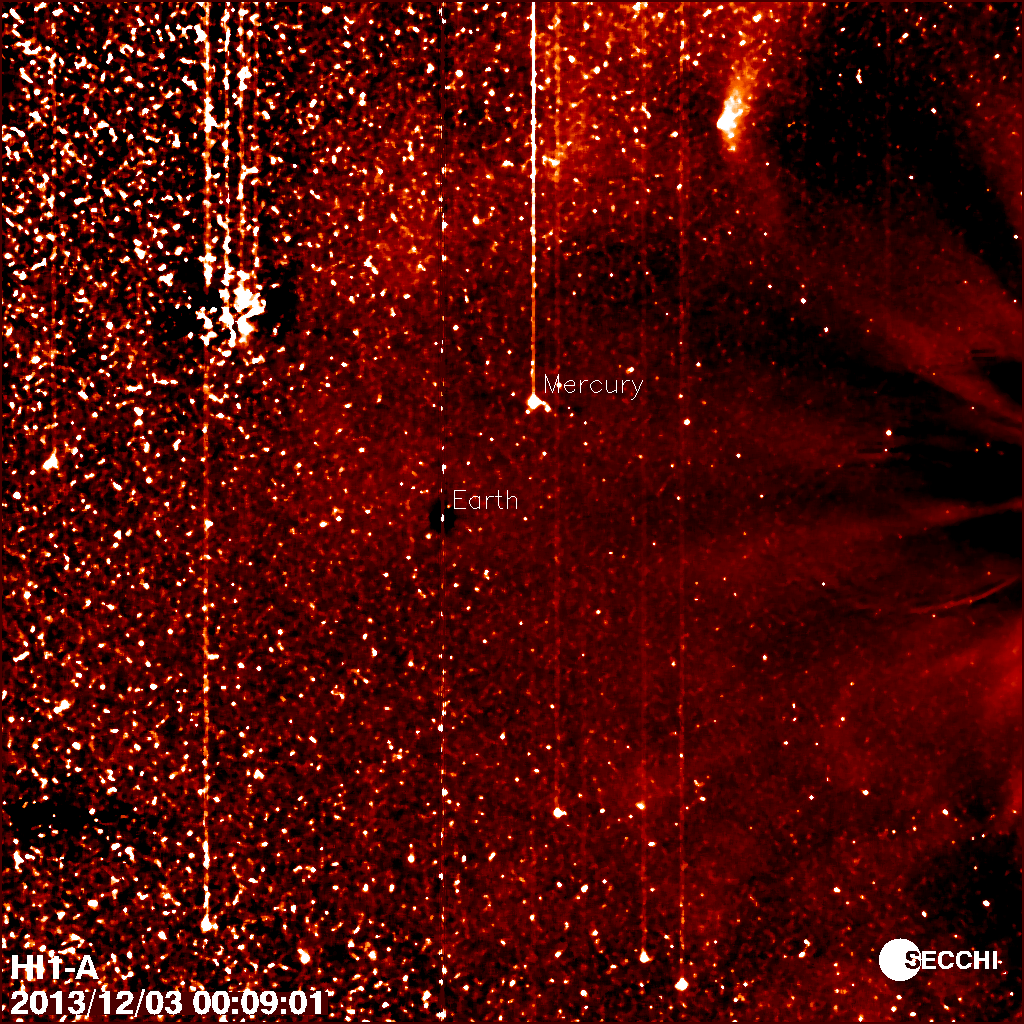
Could Comet ISON possibly still be alive? The latest high-resolution images available from the STEREO spacecraft are still showing some remains of the comet, although each day seems to show less and less activity. “If anything of ISON’s nucleus is left, it’s an inactive husk of a nucleus now,” Karl Battams from the Comet ISON Observing Campaign told Universe Today. “The comet remnant is fading fast in the STEREO data.”
Casey Lisse, also from CIOC was a bit more hopeful. In a web posting yesterday (Dec. 4) he said, “At this time, scientists are not sure how much of the comet survived intact. We may be seeing emission from rubble and debris in the comet’s trail, along its orbit, or we may be seeing the resumption of cometary activity from a sizable nucleus-sized chunk of ISON.”
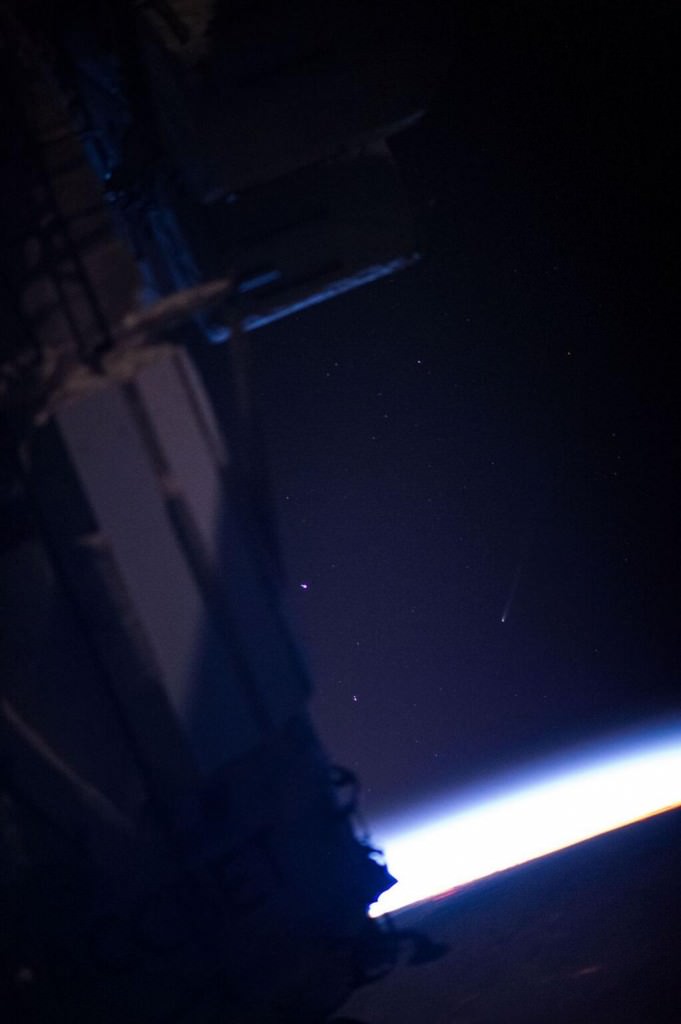
Lisse added that most astronomers agree that Comet ISON was destroyed (with greater than 90% probability of this having occurred), leaving behind small (less than 10 m radius from the original 1 km nucleus) pieces of rubble, but there could be fragments 100 meters radius or larger. This would be big enough for astronomers to study but probably not big enough to provide a nice sky display later in December that everyone was hoping for.
Here’s the schedule of events for spacecraft to study whatever is left of Comet ISON, according to Lisse:
– NASA will monitor the comet for the next several weeks. If there is nothing sizable and stable left, it will dissipate and disappear in this time, as already emitted dust leaves the vicinity. If there is still a central source of emission, even if it is very much smaller, we will see a new, much fainter coma and tail form, which currently may be overwhelmed by the dust emitted from before the disruption event.
– NASA’s STEREO spacecraft will be using their cameras to search for bright fragments throughout the week, while the NASA Infrared Telescope Facility (IRTF) in Honolulu, Hawaii will use its 3m wide telescope to detect the comet spectroscopically, the same way it did on ISON’s inbound journey. Radio telescopes around the world will also be able to tell us more about what has happened. NASA’s recently launched MAVEN spacecraft may try to observe ISON next week. By mid- to late-December NASA’s Hubble and Chandra observatories will be performing deep outer space searches for any remnants of the comet. Spitzer will also look for ISON in early 2014.
If a fragment that acts like a comet is detected, but at a much reduced level, it may be hard to see it from the Earth at the time of its closest approach on December 26, 2013.
You can find out the latest on what is going on with ISON tomorrow, Dec. 6, 2013 as the CIOC is holding a post-perihelion workshop to discuss the status of the comet. The morning sessions, live from theh Applied Physics Lab at Johns Hopkins University will be webcast from approximately 8:30 am EST to 11:30 am EST, will be available for viewing in the player below:
More details on the meeting are available here.
So far, 12 spacecraft and the International Space Station have observed and detected Comet ISON on its multi-million year journey from the Oort Cloud to the solar corona. You can find out more about the planned Hubble observations here.
Gorgeous Astrophoto: Montage of Comet ISON

Astrophotographer Damian Peach has wowed us with his images of Comet ISON the past few months. Here’s a montage of some of his best images from September 24 to November 15.
“This may well be my final word on it.” Damian said via email, “but here it is growing in brightness on approach to its best in mid-late November.”
And while it appears there’s a ghost of ISON out there with a blob of dust in the latest views from the Sun-studying satellites, it won’t give us the views we had hoped for. But its been a fun experience the past few months, watching what unfolded. Thanks for bringing us along for the ride with your images, Damian!
Astronomy Cast 324: Sun Grazers
Comets can spend billions of years out in the Oort Cloud, and then a few brief moments of terror orbiting the Sun. These are the sun grazers. Some survive their journey, and flare up to become the brightest comets in history. Others won’t survive their first, and only encounter with the Sun.
Continue reading “Astronomy Cast 324: Sun Grazers”

